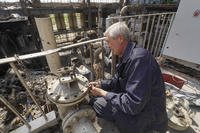 The Marine Corps is conducting ground, humidity and endurance testing on its new CH-53K Super Stallion heavy lift helicopter slated to fly next year.
The Marine Corps is conducting ground, humidity and endurance testing on its new CH-53K Super Stallion heavy lift helicopter slated to fly next year.
The new helicopter, designed as an upgrade to the existing CH-53E Super Stallion helicopter, is engineered to carry 27,000 pounds of cargo out to distances of 110 nautical miles, stay 30 minutes on station and then return -- all while performing in high hot conditions.
The new helicopter is being developed, in part, to support special Marine Air Ground Task Force, or MAGTF, units with improved stand-off range, endurance, and cargo-carrying capacity, Marine Corps officials said.
The CH-53K is being engineered for the full range of military operations to include humanitarian and non-combat missions along with joint forcible entry missions, said Maj. Eric Purcell, a Marine heavy helicopter requirements officer.
“We’re basically putting the aircraft through the flight regimes that the flying aircraft will see and really testing out the transmissions and the dynamic components on the aircraft, the fuel systems and any subsystem on the aircraft is being put through its paces,” said Col. Hank Vanderborght, H-53 Helicopters program manager for the Naval Air Systems Command
The program is about one third of the way through its ground testing. The ground testing includes conducting high risk engine tests of the GE-408 engine.
Technical challenges have delayed plans for the first flight from this year to next year, Vanderborght explained.
“The program is progressing well, we have had technical challenges on the program and most of those are behind us. Nothing out of the ordinary for a development program I think we are beyond the wave of technical issues and on a glide slope to achieving our first flight,” Vanderborght.
Part of the challenge has involved working on the aircraft’s parts in order to ensure they can hold up for the complete 30-year service life of the aircraft, he added.
"We’re trying to make sure we have optimized the design for the life of the components. There are many gears we have to ensure that every one of those gears are optimized so that they last the amount of time that we want them to last once the helicopter is fielded,” said Vanderborght.
The CH-53K effort is not new to some programmatic struggles and delays. The program office says they are on track after an April 2011 Government Accountability Office report on the program raised concerns about cost growth and schedule delays with the CH-53K. Overall, the program plans to reach operational status by 2019, a full four years behind its original schedule.
The report, titled, “CH-53K Helicopter Program has Addressed Early Difficulties and Adopted Strategies to Address Future Risks,” credits the program for implementing strategies to delay production and increase developmental funding, but cites a history of problematic cost growth for the effort.
Improved Performance
The CH-53K’s payload capacity is three times that of the existing CH-53E model helicopters which can carry up to 9,000 pounds, said Vanderborght.
This can be achieved, in part, because the helicopter is being built with lighter-weight composite materials, materials able to equal or exceed the performance of traditional metals at a much lighter weight. The helicopter includes aluminum and titanium, said Michael Torok, vice president of 53K Programs for Sikorsky Aircraft Corporation.
The beam structure and skins are all composite as well, and the rotor blades are a combination of new airfoils, taper and a modification of the tip deflection of the blade, he explained.
The altitude testing on the aircraft is done in a test chamber and an important requirement for the endurance testing is to get 100 hours of flying on the aircraft on the ground before it takes its first flight in the air.
“In parallel to the first flight, we will continue to run the ground test vehicle so that if there are any issues that may come up we find them on the ground vehicle before we find them on the aircraft. Earlier you discover things, you can more affordably address them,” Vanderborght added.
Overall, the Marine Corps plans to build as many as 200 CH-53K helicopters at an approximate price of about $70 million per aircraft. The Corps plans to have a fully operational fleet of CH 53K helicopters by 2028 in order to serve out through the 2050s. The aircraft is slated to enter production in 2016.
“The CH 53K represents is not just the continuation of heavy lift capability but really a transformation of what we are going to be able to do. It is going to ensure that the Marine Corps remains our most ready force,” said Purcell.
Afghanistan
He described a potential scenario in Afghanistan to illustrate the expected value of the CH-53K. With today’s current CH-53E heavy lift helicopter, pilots would need to fly three separate missions to deliver 9,000-pounds of supplies to three different forward operating base 30, 60 and 90 miles away – each time returning to get fuel.
“In a CH-53K you will be able to do that mission with a triple hook system attaching three different cargo loads to three different hooks on the aircraft,” he said.
The CH-53K is also being developed with what’s called a “split-torque” configuration, Torok explained. A split-torque transmission design transfers high-power, high-speed engine output to lower-speed, high-torque rotor drive in a weight efficient manner.
Split torque allows the helicopter to operate with more power without necessarily adding weight to the design.
“With the split torque you take the high-speed inputs from the engine and you divide it up into multiple pieces with multiple gear sets that run in parallel. As you split that, you can keep the amount of torque running through any path less and because you do that you can keep the weight that is needed to support that less,” Torok said. “The other benefit of having that multiple path is it is redundancy if it is hit by a threat it is safer redundancy built in.”
The helicopter will also be configured with Directional Infrared Countermeasures, or DIRCM, a high-tech laser-jammer designed to throw incoming missiles off course.
The K model will be a “fly by wire” capable helicopter and also use the latest in what’s called conditioned-based maintenance, a method wherein diagnostic sensors are put in place to monitor systems on the aircraft in order to better predict and avert points of mechanical failure, Corps official said.








